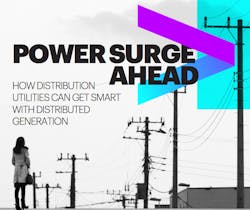Distributed generation growth is throwing a wrench in utility distribution, according to a new study from Accenture, “Power Surge Ahead: How Distribution Utilities Can Get Smart with Distributed Generation.”
Power Surge Ahead Report, Accenture
Fifty-nine percent of utility executives surveyed by Accenture expect small-scale distributed generation to stress their network hosting abilities and 66 percent of executives said they expect their role to transition toward distributed energy integration and market facilitation, said the report, based on a survey of more than 100 utility executives in more than 20 countries.
Utility executives say they are worried about the impact on their revenues of the booming growth of distributed generation.
North America and Asia particularly vulnerable
Fifty-eight percent of the executives surveyed think distributed generation will reduce their revenues by 2030. North American and Asia is particularly vulnerable because vertically integrated utilities must grabble with the one-two punch of lowered energy sales revenues and boosted network costs to provide reliable delivery, the report said.
Executives surveyed said the biggest stress on utilities’ network hosting capacity will come from energy prosumers who are investing in small-scale distributed generation. A second challenge is medium- or high-voltage connected distributed generation, including large-scale solar plants, according to the report.
About 60 percent of executives surveyed said they expect increased numbers of grid faults by 2020 as a result of distributed renewable energy.
The executives cited increased backflow of power into distribution substations and voltage issues as sources of reliability challenges.
“Accordingly, a similar proportion (60 percent ) expect the role their company plays to evolve toward serving as an integrator of DER services and acting as a market facilitator for new consumer services and value realization,” the report says.
Nearly 60 percent of those surveyed believe they will exhaust their distributed generation hosting capacity within 10 years, the report says. After 10 years, the utilities will face high capital costs of reinforcing their systems.
“In the face of such disruption, only 14 percent of distribution utilities have a very clear forecast of their potential distributed generation network hosting capacity,” said a summary of the report.
“To solve the problems outlined in the report, utilities need to embrace smart grid solutions…”
$20B for reinforcement and automation
Accenture estimates that to host small-scale distributed generation by 2030, utilities will need to come up with $20 billion in the US for network reinforcement and automation.
“Thanks to its ability to decrease loads on certain assets and reduce some network losses, small-to-moderate distributed generation penetration could initially benefit network performance, depending on the location of the distributed generation. But this is likely to be just a brief honeymoon period,” says the report.
Driving all the change in part is consumers saying they are considering investing in distributed generation to become self-sufficient. What’s more, 61 percent of consumers are interested in an online marketplace to sell the electricity they produce.
In addition to saying they want to sign up for rooftop solar or become energy self-sufficient, consumers say their energy suppliers should provide the services to support and fulfill these desires.
“Nearly six out of 10 consumers expect energy providers to work with others to offer packages for distributed energy resources (DER) that can enable them to access more sustainable ways to generate and store electricity,” says the report.
In some markets with high rates of distributed generation, consumers want such services now, and utilities have begun to respond, says the report. They’re offering new services such as solar PV installation and maintenance.
Constraining distributed generation growth won’t work
Meanwhile, it doesn’t make sense to rely on regulatory constraints to limit distributed generation growth in networks, the report says. This may help avoid some increases in network costs in the short term, but a regulation-based strategy slowing growth in distributed generation may not be sustainable, the report says.
“What’s more, inherent in consumers’ economic assessment is an assumption around the ability to export generation back to the grid. If consumers are not able to do this—either due to limited technical capacity or through reduced economic value—the result will be an acceleration in the deployment of storage, causing an even larger impact on total demand,” says the report.
To solve the problems outlined in the report, utilities need to embrace smart grid solutions, including incentives to direct new distributed generation to certain locations on the network, especially during periods of peak demand.
“By making better use of smart meter and network sensor data, along with digital asset management and network modeling
capabilities, distribution utilities would be able to undertake far more granular analyses to assess and optimize hosting capacity across the network,” the report says.
And such smart grid solutions could allow for control of distributed generation exports at critical times, the report says.
“The resulting greater control could also enable the use of demand response to better manage grid performance, and encourage more storage capacity and smart inverters onto the grid to create new services and revenue,” says the report.
All in all, utilities need to take action, says the report. They shouldn’t wait until the honeymoon is over.
Follow Microgrid Knowledge on our LinkedIn Group, Distributed Energy Resources.








